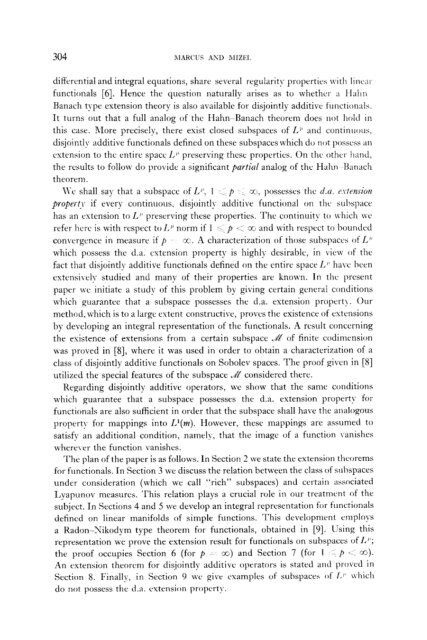Extension Theorems of Hahn-Banach Type for Nonlinear Disjointly ...
Extension Theorems of Hahn-Banach Type for Nonlinear Disjointly ...
Extension Theorems of Hahn-Banach Type for Nonlinear Disjointly ...
You also want an ePaper? Increase the reach of your titles
YUMPU automatically turns print PDFs into web optimized ePapers that Google loves.
di&rcntial and integral equations, share several regularity properties \vith linca~-<br />
functionals [6]. Hence the question naturally arises ai to whether a <strong>Hahn</strong><br />
<strong>Banach</strong> type extension theory is also available <strong>for</strong> disjointly additive functionals.<br />
It turns out that a full analog <strong>of</strong> the <strong>Hahn</strong>-<strong>Banach</strong> theorem does not hold in<br />
this case. More precisely, there exist closed subspaces <strong>of</strong> LJ’ and continuous,<br />
disjointlv additive functionals defined on these subspaces which do not l~osscss an<br />
cxtcnsion to the entire space 1,” preserving these properties. On the other hand,<br />
the results to follow do provide a significant partinl analog <strong>of</strong> the <strong>Hahn</strong> Hanach<br />
theorem.<br />
1Vc shall say that a subspace <strong>of</strong> LJ’, 1 ‘_ p ’ ._ ,a, possesses the d.a. P.\‘te?1Sion<br />
proper!\’ if every continuous, disjointly additive functional on the subspace<br />
has an extension to L” preserving these properties. The continuity to which WC’<br />
refer here is with respect to 1,” norm if I --. p -: sci and with respect to bounded<br />
convergence in measure if p W. A characterization <strong>of</strong> those subspaces <strong>of</strong> L”<br />
which possess the d.a. extension property is highly desirable, in view <strong>of</strong> the<br />
fact that disjointly additive functionals defined on the entire space Z,” have been<br />
extensi\-cl!- studied and many <strong>of</strong> their properties are known. In the present<br />
paper we initiate a study <strong>of</strong> this problem by giving certain gcnerai conditions<br />
which guarantee that a subspace l~ossesses the d.a. extension propcrt!. Out<br />
method, which is to a large extent constructive, proves the existence <strong>of</strong> extensions<br />
by developing an integral representation <strong>of</strong> the functionals. A result concerning<br />
the existence <strong>of</strong> extensions from a certain subspace J&’ <strong>of</strong> finite codimension<br />
was proved in [S], where it was used in order to obtain a characterization <strong>of</strong> a<br />
class <strong>of</strong> disjointly additive functionals on Sobolev spaces. The pro<strong>of</strong> given in [8]<br />
utilized the special features <strong>of</strong> the subspace J&’ considered there.<br />
Regarding disjointly additive operators, we show that the same conditions<br />
which guarantee that a subspace possesses the d.a. extension propert>- <strong>for</strong><br />
functionals are also sufficient in order that the subspace shall have the analogous<br />
property <strong>for</strong> mappings into U(m). However, these mappings are assumed to<br />
satisfy an additional condition, namely, that the image <strong>of</strong> a function vanishes<br />
\vhere\-er the function vanishes.<br />
The plan <strong>of</strong> the paper is as follows. In Section 2 we state the extension theorems<br />
<strong>for</strong> functionals. In Section 3 we discuss the relation between the class <strong>of</strong> suhspaces<br />
under consideration (which we call “rich” subspaces) and certain associated<br />
Lyapunov measures. This relation plays a crucial role in our treatment <strong>of</strong> the<br />
subject. In Sections 4 and 5 we develop an integral representation <strong>for</strong> functionals<br />
defined on linear manifolds <strong>of</strong> simple functions. This development employs<br />
a Radon-Nikodym type theorem <strong>for</strong> functionals, obtained in [9]. Using this<br />
representation we prove the extension result <strong>for</strong> functionals on subspaces <strong>of</strong> L”;<br />
the pro<strong>of</strong> occupies Section 6 (<strong>for</strong> p ~~ co) and Section 7 (<strong>for</strong> I 1 p -:. m).<br />
An extension theorem <strong>for</strong> disjointly additive operators is stated and proved in<br />
Section 8. Finally, in Section 9 WC‘ give examples <strong>of</strong> subspaces <strong>of</strong> I,” kvhich<br />
do not possess the d.a. extension property.

















